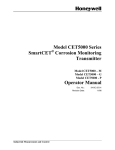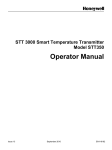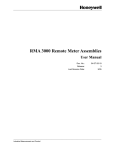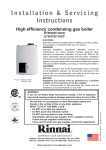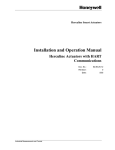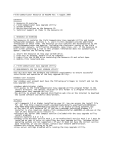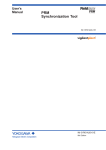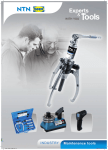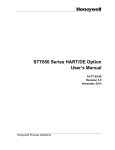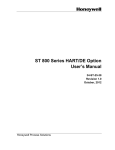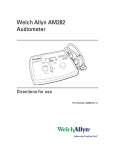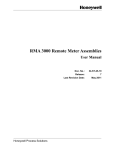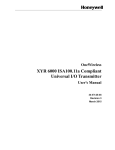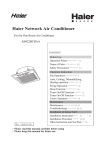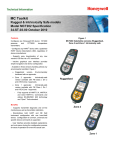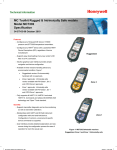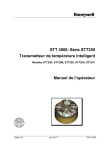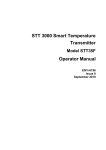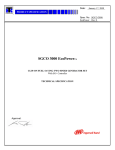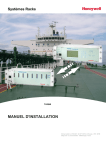Download TABLE OF CONTENTS
Transcript
STT 3000 - Series STT250 Smart Temperature Transmitter Models STT25D, STT25M, STT25H, STT25S, STT25T Operator Manual Issue 9 - 9/08 EN1I-6190 HONEYWELL TABLE OF CONTENTS 1. OVERVIEW ..........................................................................................................1 1.1 INTRODUCTION ..................................................................................... 1 2. TECHNICAL SPECIFICATIONS..........................................................................2 2.1 ENVIRONMENTAL CONDITIONS ............................................................... 2 3. THEORY OF OPERATION ..................................................................................3 3.1 BASIC OPERATION ................................................................................ 3 3.2 CONFIGURATION TOOLS ........................................................................ 4 3.2.1 3.2.2 3.2.3 3.2.4 3.2.5 3.2.6 3.2.7 4. Smart Field Communicator (SFC) for STT25M and STT25D Models........................................4 HART Communicator (Model 275) for STT25H Models.................................................................5 HART Communicator (Model 275) for STT25T Models.................................................................6 HART Communicator (Model 375) for STT25S Model...................................................................7 Smartline Configuration Toolkit (SCT)....................................................................................................8 STT25H Firmware – DD Compatibility matrix.....................................................................................9 STT25S Firmware – DD Compatibility matrix...................................................................................10 BENCH CHECK INSTALLATION/COMMISSIONING.......................................11 4.1 4.2 4.3 4.4 4.5 UNPACKING........................................................................................ 11 EQUIPMENT........................................................................................ 11 INSTALLATION ..................................................................................... 11 GROUNDING AND SHIELDING TECHNIQUES ............................................ 13 STT250 CONFIGURATION ................................................................... 13 4.5.1 4.5.2 4.5.3 4.5.4 Analog Output Configuration (based on STS103) for STT25M and STT25D Models.........14 DE Digital Output Configuration.............................................................................................................17 HART Configuration (STT25H and STT25S Models)...................................................................18 HART Configuration (STT25T Model).................................................................................................20 4.6 MOUNTING ......................................................................................... 27 4.6.1 DIN Rail Mounting......................................................................................................................................27 4.6.2 Mounting Module in Housing..................................................................................................................27 4.7 COMMISSIONING ................................................................................. 30 4.8 START UP .......................................................................................... 31 5. MAINTENANCE/TROUBLESHOOTING............................................................32 5.1 MAINTENANCE .................................................................................... 32 5.2 TROUBLESHOOTING ............................................................................ 32 5.2.1 Troubleshooting with SFC (STT25M and STT25D Models)........................................................32 5.2.2 Troubleshooting with HART communicator (STT25H, STT25S, and STT25T Models).....35 5.3 RECOMMENDED PARTS ....................................................................... 39 5.4 WIRING AND INSTALLATION DRAWINGS NUMBERS .................................. 40 6. INDICATION METERS.......................................................................................41 6.1 INTRODUCTION ................................................................................... 41 6.2 CONNECTION INFORMATION ................................................................. 41 6.3 INSTALLATION/COMMISSIONING ............................................................ 42 6.3.1 Transmitter Operating in 6 Byte Output Mode...................................................................................42 6.3.2 Transmitter Operating in 4 Byte Digital Output or in 4-20 mA Analog Mode............................42 Smart Temperature Transmitter STT250 – Operator Manual iii 6.3.3 Transmitter Operating in 4-20 mA Analog Output Mode...............................................................42 6.4 DIAGNOSTIC AND TROUBLESHOOTING ................................................... 43 6.4.1 Analog Meter...............................................................................................................................................43 6.4.2 Smart Meter.................................................................................................................................................43 6.4.3 4-20 mA Analog Mode Calibration of Smart Meter..........................................................................45 APPENDIX A A.1 A.2 A.3 A.4 A.5 A.6 A.7 TRANSIENT PROTECTOR INSTALLATION INSTRUCTION ....47 OVERVIEW ......................................................................................... 47 FEATURES AND BENEFITS .................................................................... 47 ELECTRICAL CHARACTERISTICS ........................................................... 47 INSTALLATION PROCEDURE.................................................................. 48 WIRING REFERENCE ........................................................................... 49 FM CONTROL DRAWING 46188466-201 .............................................. 50 CSA CONTROL DRAWING 46188466-202............................................ 58 FIGURES AND TABLES Figure 1: Operating Areas ............................................................................ 2 Figure 2: Bench Check Wiring Connections .............................................. 11 Figure 3: Output Sensor Wiring Connections (STT25 M, STT25D, STT25H, and STT25S models) .......................................................... 12 Figure 4: Input Sensors Wiring Connections (STT25T Model) ................. 13 Figure 5: Flow Chart for analog and DE Configuration ............................ 16 Figure 6: Flow Chart for STT25 H Configuration...................................... 19 Figure 7: Flow chart for STT25T Configuration ........................................ 21 Figure 8: DIN Rail Mounting ..................................................................... 27 Figure 9: Wall Mounting Dimensions ........................................................ 28 Figure 10: Pipe Mounting Dimensions....................................................... 28 Figure 11: Spring Loading and Sensor Assembly ...................................... 29 Figure 12: Aluminium Direct Head Mount Housing Dimensions .............. 30 Figure 13: Cast Iron Direct Head Mount Housing Dimensions.................. 30 Figure 14: Meters Connections................................................................... 41 Figure 15: Horizontal Style Bargraph......................................................... 43 Figure A-1: Typical wiring of transient protector to STT250 transmitter . 49 iv Smart Temperature Transmitter STT250 – Operator Manual 1. OVERVIEW 1.1 Introduction The STT250 Smart Temperature Transmitter is a microprocessor based unit suitable for accepting a wide variety of thermocouple and resistance temperature detector sensor inputs or direct ohm or milli-volt inputs and providing a 2 wire 4-20 mA “Analog”, digital “DE”, or analog “HART®” proportional output. The transmitter offers high accuracy and stability together with wide flexibility to suit a wide range of applications. All adjustments and operational settings are implemented through the Smart Field Communicator (DE) or the HART communicator (HART). Both field communicators access the transmitter by connecting across the 4-20 mA wiring in parallel with the STT250 anywhere along the wiring up to 1500 meters from the transmitter for both the DE and HART protocol versions. Note: 1500 m is the maximum HART cable length but may be restricted by cable capacitance limits. Model STT25M provides a 4-20mA analog output and is configurable with the Honeywell Smart Field Communicator (SFC) or the PC based Smartline Configuration Toolkit (SCT). Model STT25D provides both the 4-20mA analog output as in Model STT25M or the digital DE protocol for digital integration to the Honeywell control system or other compatible interfaces. Model STT25H provides the HART protocol output. The terminal assembly is blue for visible differentiation. Model STT25S provides the HART 6.0 protocol output and TUV SIL 2 safety rating. The terminal assembly is blue for visible differentiation. Model STT25T provides two sensor inputs, a primary and a secondary, and can compare them either for redundant switch over (except with RTD/RTD) or as an indicator of sensor degradation. These two inputs may be both thermocouples, both RTD’s or one of each. It is configurable with the HART hand held communicator or a PC based HART maintenance system (such as Cornerstone). The STT250 is based on a rugged compact package with encapsulated electronics for high reliability and includes facilities for spring loading of the sensor at a 33 mm pitch in accordance with DIN 43729. The unit is available either for DIN rail mounting or supplied in a variety of enclosures for direct sensor, pipe or wall mounting (See Figures 8 through 13). “HART is a Registered Trademark of HART Communication Foundation.” “The STT3000 Smart Temperature Transmitters are manufactured under at least one of the following patent numbers: 4.734.873, 4.592.002, 4.587.466, 4.553.104, 4.494.183” Smart Temperature Transmitter STT250 – Operator Manual 1 2. TECHNICAL SPECIFICATIONS 2.1 Environmental Conditions Reference Temperature 23°C 73°F Humidity (%RH) Supply voltage 10 to 55 Rated conditions -40°C to 85°C -40°F to 185°F Operating limits -40°C to 85°C -40°F to 185°F -50°C to 100°C -58°F to 212°F 5 to 95 5 to 100 5 to 100 24 V / 250 Ω Storage (See Figure 1) Shock/ Vibration 40 g max 4 g max over 15-200 Hz (3 g with meter) CE MARK compliance: In compliance with EMC directive 89/336/ECC: - without shielded wires 10 V/m, ± 0.2% of Max span - with shielded wires and mounted in metallic housing: 30 V/m, ± 0.1% of max span. Load resistance (Ohms) 1100 Load resistance (Ohms) operating communication area operating communication area 1100 operating area with no communication operating area with no communication 250 Supply voltage (Vdc) 0 0 10.8 16.3 35 V 100 0 0 10.8 13 DE operating area 35 V HART operating area Figure 1: Operating Areas 2 Smart Temperature Transmitter STT250 – Operator Manual Supply voltage (Vdc) 3. THEORY OF OPERATION 3.1 Basic Operation As shown in Figure 2, the transmitter is powered via the 2 wire, 4-20 mA signal connected to the + and - terminals on the output side of the module. Inputs are sampled and the input sampling/output update rate is once per second, digitized by the A/D converter. Data is then transferred across the galvanic isolation interface (both power supply and signal interface of the A/D converter are galvanically isolated), compensated for cold junction or resistance lead length. The process value is post read validated for sensor wiring and signal integrity against reference values. Digital data is then linearized and ranged to the lower and upper range values held in non volatile memory and converted back to an analog signal. Any configuration changes are held in non volatile memory so that they are secured against power failure. If a custom configuration was not specified, the data programmed into the non volatile memory of the unit at the manufacturing location is the default shipping data shown below. Sensor type STT25M and STT25D mV Sensor fault detection Tag I. D. Latching Line filter Output type Write protect Password Damping LRV (Lower Range Value) URV (Upper Range Value) Output mode Digital DE conf. Long Tag STT25H STT25T TC/TC, TC j STT25S mV ON Short Tag Disabled 50 Hz (Amiens) - 60 Hz (Phoenix) Non-linear Disabled (1) 0000 Linear N/A N/A Non-linear Disabled (1) 0000 0 second 0 mV -200 °C -20mV 45 mV 1200 °C 150mV Analog 6 byte/Single rng.-S V N/A NA Long Tag The data can be configured in the field by connecting a Communicator across the 4-20 mA wires or a PC. The fail-safe link between the + and - terminals determines where the output will drive when the STT250 detects an open sensor input or internal failure. The unit will drive upscale to 21.8 mA when the fail-safe link is in the U position and downscale to 3.8 mA in the D position. The output of the STT250 can be 4-20mA analog (DE or HART) or digital DE protocol. The digital DE output is used primarily with Honeywell’s control system where it improves performance by avoiding conversion to/from an analog signal and offers full database integration of field transmitters with the central control system. (1) To protect the integrity, write protect is software configurable and accessible through a password. The fall-back password is an algorithm based on the unit serial number. If the password is lost, contact your regional Technical Assistance Center (TAC) with the unit serial number. Smart Temperature Transmitter STT250 – Operator Manual 3 3.2 Configuration Tools 3.2.1 Smart Field Communicator (SFC) for STT25M and STT25D Models As previously indicated, the SFC communicates by connecting across the 4-20 mA wiring. DE Communication is by 16 mA pulses which disturb the 4-20 mA output signal. When in analog mode, ensure that receiving instruments are not on automatic control. The SFC does not feed 16 mA pulses into the loop but instead merely uses the power on the 4-20 mA wires and switches it through a field effect transistor output switch. The SFC always acts as a master and the transmitter as a slave. When the transmitter is operating in the digital DE mode, there is no wake-up pulse required and the SFC communication does not disturb the PV signal. Consequently, there is no need to put the loop on manual control when operating in the DE mode. ∗ ∗ ∗ ∗ ∗ ∗ ∗ ∗ ∗ ∗ ∗ ∗ ∗ ∗ ∗ ∗ ∗ ∗ ∗ ∗ ∗ (1) 4 Supported Commands: Read/write ID (e.g. TID 250) Select a sensor type (e.g. Pt100) Select linear/non linear reading (i.e. Linear for °C etc., Non linear for Ω and V) Enable/disable sensor break detection Set damping time (e.g. 0 second) Write/change LRV and URV Set LRV and URV Read URL (upper range limit), LRL (lower range limit) and span Read process value and cold junction value in engineering units Read output in % of span Read STT250's software version Read fail-safe direction configured by link Set/reset user calibration to specific sensor Set 0 and 100% output calibration Force output current Read/write scratch pad Select broadcast type 4 or 6 bytes (Digital DE only). 6 bytes broadcasts PV and transmitter database while 4 bytes broadcasts PV only Enable/disable write protect Select 50 Hz/60 Hz power line filter Enable/disable latching. Latching means the alarm needs acknowledgment. Press "STATUS" key to acknowledge the alarm. If latching is disabled, the STT250 will leave the alarm mode as soon as the alarm cause disappears. (1) Change to NAMUR output levels Not available on STT25D Smart Temperature Transmitter STT250 – Operator Manual 3.2.2 HART Communicator (Model 275) for STT25H Models The HART Communicator communicates by connecting across the 4-20 mA wiring. Communication is by a high frequency carrier superimposed onto the 4-20 mA signal. The HART transmitter transmits by modulating the 4-20 mA DC loop current with a 1 mA p-p AC current signal. This modulated signal does not disturb the output signal (PV) since the average value of the communication signal is zero. Thus, it is unnecessary to put the loop on manual control with Model STT25H. ∗ ∗ ∗ ∗ ∗ ∗ ∗ ∗ ∗ ∗ ∗ ∗ ∗ ∗ ∗ ∗ ∗ ∗ ∗ ∗ ∗ ∗ ∗ Supported Commands: Read/write ID Select sensor type Select units Write/change LRV and URV Set LRV and URV Select damping time Read URL and LRL Read process value and cold junction value Read analog output Read PV Read % Output Read CJ Read STT250's software version Read fail-safe direction Set/reset user calibration Set 0% and 100% output calibration Read/write scratch pad Force output current Enable/disable latching Read/write multidrop address Read device status Set/clear write protect Read/write message, descriptor, date Smart Temperature Transmitter STT250 – Operator Manual 5 3.2.3 HART Communicator (Model 275) for STT25T Models The HART Communicator communicates by connecting across the 4-20 mA wiring. Communication is by a high frequency carrier superimposed onto the 4-20 mA signal. The HART transmitter transmits by modulating the 4-20 mA DC loop current with a 1 mA p-p AC current signal. This modulated signal does not disturb the output signal (PV) since the average value of the communication signal is zero. Thus, it is unnecessary to put the loop on manual control with the STT25T model. ∗ ∗ ∗ ∗ ∗ ∗ ∗ ∗ ∗ ∗ ∗ ∗ ∗ ∗ ∗ ∗ ∗ ∗ ∗ ∗ ∗ ∗ ∗ ∗ ∗ ∗ ∗ ∗ ∗ 6 Supported Commands: Read/write ID select Dual Mode TC/TC, RTD/RTD, RTD/TC (STT25T Model) Select sensor type Select units Write/change LRV and URV Set LRV and URV Select damping time Read URL and LRL Read process value and cold junction value Read analog output Read PV Read PV1 and PV2 (STT25T Model) Read % Output Read CJ Read STT250's software version Read fail-safe direction Set/reset user calibration Set 0% and 100% output calibration Read/write scratch pad Force output current Enable/disable sensor break detection (not available on STT25T Model) Enable/disable latching Read/write multidrop address XS Delta detection ON/OFF (STT25T Model) Set Delta Alarm (STT25T Model) Read Delta (STT25T Model) Match PVs (STT25T Model) Read device status Set/clear write protect Smart Temperature Transmitter STT250 – Operator Manual 3.2.4 HART Communicator (Model 375) for STT25S Model The HART Communicator communicates by connecting across the 4-20 mA wiring. Communication is by a high frequency carrier superimposed onto the 4-20 mA signal. The HART transmitter transmits by modulating the 4-20 mA DC loop current with a 1 mA p-p AC current signal. This modulated signal does not disturb the output signal (PV) since the average value of the communication signal is zero. Thus, it is unnecessary to put the loop on manual control with Model STT25S. ∗ ∗ ∗ ∗ ∗ ∗ ∗ ∗ ∗ ∗ ∗ ∗ ∗ ∗ ∗ ∗ ∗ ∗ ∗ ∗ ∗ ∗ ∗ ∗ ∗ ∗ ∗ Supported Commands: Read/write ID Select sensor type Select units Write/change LRV and URV Set LRV and URV Select damping time Read URL and LRL Read process value and cold junction value Read analog output Read PV Read % Output Read CJ Read STT250's software version Read fail-safe direction Set/reset user calibration Set 0% and 100% output calibration Read/write scratch pad Force output current Enable/disable latching Read/write multidrop address Read device status Set/clear write protect Read/write long tag ID Read/write loop current mode Addressing 0 to 63 Lock/unlock device Read/write message, descriptor, date Smart Temperature Transmitter STT250 – Operator Manual 7 3.2.5 Smartline Configuration Toolkit (SCT) The SCT supports several Smartline products which use the DE protocol, including the STT350, STT25M and STT25D. Since the STT25M and STT25D configuration/data are a subset of the STT350, most functions are supported by the current version of the SCT software. The only confusion which may occur is if you try to configure the STT250 for functions which are available only with the STT350 transmitter, as shown below. • • • • • Sensor types C, D, Ni/NiMo, Radiamatic, Pt500, Ni500, Cu10 and Cu25 are only available with STT350. External cold junction compensation is only available with STT350. High/Low PV read is only available with STT350. SCT does not support HART protocol and should not be used with Model STT25H, STT25S, and STT25T. The STT25M cannot be changed from analog to digital DE mode. To access to the new functionalities of the STT25M and STT25D, you need a SCT3000 Version 154 or greater. 8 Smart Temperature Transmitter STT250 – Operator Manual 3.2.6 STT25H Firmware – DD Compatibility matrix This compatibility matrix includes a listing the DD files that should be used with a revision of the transmitter firmware. Firmware Revision SDC625: HCF DD files … … 19 … … 0207.fms Rosemount 375: Emerson DD Files … … 17040207.hdd 17040207.hhd Location of the DD files The HCF DD files are located at: http://hpsweb.honeywell.com/Cultures/enUS/Products/Instrumentation/SoftwareTools/MCToolkit/SoftwareDownloads/document s.htm Emerson DD Files are located at TBD DD Installation Instructions MC Toolkit SDC625: Copy the files to the following Release folder structure under SDC625 installation directory on the Pocket PC …\Release\000017\0004 Rosemount 375: • Copy the files to the 375 Easy Upgrade Utility installation folder: C:\Program Files\375 Easy Upgrade Utility\PC Database\DD\HART • Update the DD files on the 375 SD Card following the Easy Upgrade instructions Smart Temperature Transmitter STT250 – Operator Manual 9 3.2.7 STT25S Firmware – DD Compatibility matrix This compatibility matrix includes a listing the DD files that should be used with a revision of the transmitter firmware. Firmware Revision SDC625: HCF DD files … 0.99 … 0101.fm6 1.0 0101.fm6 Rosemount 375: Emerson DD Files … 17090101.hdd 17090101.hhd 17090101.hhd 17090101.hdd Location of the DD files The HCF DD files are located at: http://hpsweb.honeywell.com/Cultures/enUS/Products/Instrumentation/SoftwareTools/MCToolkit/SoftwareDownloads/document s.htm Emerson DD Files are located at TBD DD Installation Instructions MC Toolkit SDC625: Copy the files to the following Release folder structure under SDC625 installation directory on the Pocket PC …\Release\000017\0009 Rosemount 375: • Copy the files to the 375 Easy Upgrade Utility installation folder: C:\Program Files\375 Easy Upgrade Utility\PC Database\DD\HART • 10 Update the DD files on the 375 SD Card following the Easy Upgrade instructions Smart Temperature Transmitter STT250 – Operator Manual 4. BENCH CHECK INSTALLATION/COMMISSIONING 4.1 Unpacking Unpack the unit and verify the contents are as ordered. 4.2 Equipment If a bench check is intended, the equipment needed is: 9 an input sensor(s) suitable for the required application or an equivalent calibrator which can simulate milli-volts, resistance temperature detector, thermocouple or resistance (ohms) inputs, 9 a nominal 24 Vdc power supply with less than 100 mV peak ripple and able to supply at least 40 mA, 9 a Smart Field Communicator (SFC) with STT25M or STT25D or HART Communicator (model 375) with STT25H, STT25S, or STT25T, 9 connection wiring and 250 ohms resistor, 9 a Digital Voltmeter (DVM) with range covering 0-5 Vdc. If a high speed sampling DVM is used, a 1 Hz (160 msec.) averaging filter is recommended. NOTE: If you are going to check calibration using a thermocouple input, ensure that the cold junction temperature is stabilized. After connecting and powering up all equipment, including the transmitter, protect the transmitter from air drafts and allow at least 1 hour before taking readings. 4.3 Installation Connect the equipment as in Figures 2 and 3. For more detailed wiring drawings, refer to drawings listed in Section 5.4. ATTENTION: Do not connect power supply to sensor wiring terminals. SFC or HART communicator 250 ohms + DVM 4-20 mA + - 24 Vdc Power supply - Figure 2: Bench Check Wiring Connections Smart Temperature Transmitter STT250 – Operator Manual 11 White White White RTD Red White RTD Red Red 2 wires RTD or 2 wires ohm 3 wires RTD or 3 wires ohm RTD Red Red 4 wires RTD or 4 wires ohm Single T/C and mV 2 wires 3 wires Potentiometer wiring 4 wires 46188466-201 Figure 3: Output Sensor Wiring Connections (STT25 M, STT25D, STT25H, and STT25S models) 12 Smart Temperature Transmitter STT250 – Operator Manual TC/TC + TC2 + - TC1 TC1 = Primary Sensor TC2 = Secondary / Check Sensor RTD/RTD (Pt 100 D) Red Red RTD 1 White White Red RTD1 = Primary Sensor RTD 2 RTD2 = Secondary / Check Sensor RTD/TC RTD 1 + TC 2 - RTD1 = Primary Sensor RTD2 = Secondary / Back-up Sensor Figure 4: Input Sensors Wiring Connections (STT25T Model) 4.4 Grounding and Shielding Techniques The current output signal will operate in either a floating or grounded system. If the signal appears noisy or erratic, it is recommended to ground the loop at the negative terminal of the power supply. Shielding should only be connected to ground at one point to avoid ground loops. 4.5 STT250 Configuration NOTE: If the transmitter is Model STT25D and configured for digital DE output, the DVM will not display the output during the bench check. The output can be changed to 4-20 mA analog for calibration checks. Remember to change the mode back to digital DE at the completion of the check. Smart Temperature Transmitter STT250 – Operator Manual 13 4.5.1 Analog Output Configuration (based on STS103) for STT25M and STT25D Models 1. Turn on the power supply and the SFC. On power up, the SFC will display "Self Check" for a few seconds, verify proper operation and display "put loop in manual". 2. Press ID button. The transmitter will respond with a display of its name, typically "STT TagNo XXXXXXXX". "STT" cannot be changed since it identifies the type of transmitter. The current name XXXXXXXX has a cursor under the first letter showing that it can be changed to an 8 character alpha-numeric tag number by using number and letter keys. NOTE: Even though the transmitter is working properly, the SFC may display "CRITICAL STATUS" and an error message when you press "STATUS". The error messages are "INPUT OPEN" "UNCERTAIN READING" "I/P OUT OF SPEC". The "CRITICAL STATUS" message is caused by one of the following: ⇒ You have not connected a sensor to the input. ⇒ There is an open circuit in the sensor, connecting wiring or terminal connections. ⇒ You have connected a T/C or other milli-volt source to the T/C terminals and the transmitter is configured for RTD input (or vice versa). 3. Press "Status" to verify "Status Check = OK" is displayed. 4. Press "Conf" to access the transmitter database and configure it as required. As mentioned earlier, the default shipping mode of engineering units is 0-45 mV input, mV range. You can now customize the unit to your specific application. The flow chart in Figure 5 gives a simplified overview of selections and key strokes. See SFC Operating Card 34-ST-11-16 for more details on Latching, NAMUR and Write Protection functionalities. In summary: - Press "Next" (or ) and "Prev" (or ) to scroll through the different categories. - Press "Menu Item" to access the possible selections of any category: the Î key steps on to the next selection while the Í key steps back to the previous selection. Note that with the "Menu Item" key you can only move to the right. 5. When a desired configuration item appears on the SFC display, this item may be configured in the SFC "Hold" memory by pressing "Enter". When you have completed configuring all items accessible via the "STT Conf" Key, or you try to exit via the "CLR" Key, the SFC will ask "Download Change?". Press "Yes" (Enter) and the changes will be down-loaded from the SFC to the transmitter, or press "No" (CLR) and the SFC hold memory will be erased. 6. Having now configured the input type etc., press "LRV" and key in the required temperature for 4 mA output (e.g. 100°C [212°F]). 7. Press "Enter" to load this into the transmitter and repeat with "URV" for the 20 mA output (e.g. 500°C [932°F]). 14 Smart Temperature Transmitter STT250 – Operator Manual Note that if the input type is changed or the output type is changed from linear to non-linear (or vice versa), the LRV and URV values will default to factory set values and the unit selection (°C/°F) will default to °C. Your STT250 is now configured for your applications. You can check out the performance by varying the input and observing the output response on the DVM. Smart Temperature Transmitter STT250 – Operator Manual 15 Keys Shift Keys A ID CONF Menu 1 Menu 2 DE READ B Enter CHANGE CONF PROBE (J, K, etc...) Enter CJ Ext / Int Line Filter Inp Fault Det O/P Linear Next LATCHING CONFIG? NAMUR CONFIG? WRITE PROTECT? DAMP UNITS LRV C URV F READ CJ G SER # Enter Enter Enter CHG LATCHING CFG? CHG NAMUR CFG *? CHG WRITE PROT? D E SET NEXT MENU ITEM H OUTPUT CORRECT PREV --> 7 8 9 <-4 5 6 STAT J LRL * Not available on STT25D I K INPUT RESET L M N O P Q A <--> DE R S T U V 1 W 2 X 3 Y SPAN Z 0 → . +/NUM / ALPHA ∧ SHIFT CLR (NO) ENTER (YES) F/S DIR SW VER URL SCR PAD NON-VOL Figure 5: Flow Chart for analog and DE Configuration 16 Smart Temperature Transmitter STT250 – Operator Manual 4.5.2 DE Digital Output Configuration The STT25D transmitter can operate in either an analog or a digital DE communications mode. You can use the Smart Field Communicator (SFC) to set transmitter operation mode as analog or digital DE communications. Note that STT25D transmitters are factory set for analog communications operation. This addendum outlines additional steps for the Configuration Flow Chart in Figure 5-1 of this Operator Manual to configure parameters for DE communications mode and change transmitter operation from analog to digital DE communications. The DE configuration parameters are: - Type of transmitter operation, - Message format, - Failsafe mode for the digital control system. Use the following flow chart to supplement in Figure 5 to configure the DE mode parameters and to set your STT25D for DE communications operation. ADDITIONAL NOTE: 1. Not all failsafe mode selections apply for given type of transmitter operation. 2. SET LRV and SET URV commands are not available on STT25D. 3. CONFIG NAMUR command is not available on STT25D. Keys Shift Keys MENU ITEM <-- I DE CONF Q Menu 1 Menu 2 1 Enter A <--> DE Type of transmitter operation (single range, dual range STDC, single range W/SV) Message format (W/O DB - 4 bytes W/DB - 6 bytes) 1 Failsafe mode (B/O Lo, B/O Hi, LKG, FSO) Change to DE? Enter Enter Are you 2 sure? Figure 5-1 : Specific Flow Chart for DE Configuration 1: These parameters are only required for older applications with ST/DC interface cards. They are not used in STI, STIM or STI-MV interface card installations except for selection of with/ without Secondary Variable (SV). 2: You cannot change to DE with a STT25M. If you attempt to do so, an "INVALID REQUEST" message will appear. Smart Temperature Transmitter STT250 – Operator Manual 17 Operating card (34-ST-11-16) included with the STS103 covers the smart transmitter functions included in the STT250 (e.g. damping, calibration, output mode etc.). Since the SFC is a universal configuration tool for a wide range of Honeywell transmitters, some proposed menu items are not possible with the STT250, as listed in Section 3.2.3. In this case, the download will result in an “invalid request” response. Additional configuration notes: 1. This series mode filter should match the local AC supply frequency. It is set to 60 Hz for United States and to 50 Hz for other countries. 2. Sensor fault detection "ON" will drive the output upscale or downscale as selected in the event of an open input condition or in response to most electronic malfunctions. Sensor fault detection "OFF" will give an indeterminate output with an open input condition. 3. "O/P linear" will always read in degrees (C, F, R or K, as selected) for T/C and RTD inputs. "O/P non linear" will read in milli-volts for T/C inputs and in ohms for RTD inputs. 4.5.3 HART Configuration (STT25H and STT25S Models) 1. Turn on the power supply and the HART Communicator. 2. On power up, the communicator will display "Self Test in Progess", verify proper operation and display "STT250 HA: xxxxxxxx" (xxxxxxxx represents the tag) and "On-line". The process value, output current, LRV and URV are displayed a few seconds later. NOTE: Even though the transmitter is working properly, the HART Communicator may display "Input Open". - Press "NEXT". "Ignore next 50 occurrences of status" is displayed. - Confirm with "YES" to correct the problem. The cause is probably one of the following: ⇒ You have not connected a sensor to the input. ⇒ There is an open circuit in the sensor, connecting wiring or terminal connections. ⇒ You have connected a T/C or other milli-volt source to the T/C terminals and the transmitter is configured for RTD input (or vice versa). 3. Press Î to select "Device setup" menu. 4. Then use Ð to highlight the "Basic setup" followed by Î to access the transmitter database and configure it as required. As mentioned earlier, the default shipping mode for units is 0-45mV input, 0-45 mV range. You can now customize the unit to your specific application. The flow chart in Figure 6 gives a simplified overview of selections and key strokes. In summary: 18 - pressing Î selects a menu, - pressing Ï or Ð accesses the selections of any category, - pressing Í steps back to the previous menu. Smart Temperature Transmitter STT250 – Operator Manual You can check out the performance by varying the input and observing the output response on the DVM. Additional note : This series mode filter should match the local AC supply frequency. 1 Process Variables 1 Device Setup 2 PV 2 Diagnostics & Services 3 PV AO 4 PV LRV 5 PV URV 3 Basic Setup 1 2 3 4 PV PV % rnge PVAO SV 1 2 3 4 5 6 Master Reset Device status Loop Test Calibration D/A trim Write protect 1 2 3 4 5 6 Tag PV Snsr Unit Enter values Device info PV Damp SV Unit 5 Review 1 Sensors 2 Signal Condition 3 Output Condition 4 Device Information 5 Alarm Apply values Enter values Correct input LRV Correct input URV Reset Corrects 1 2 3 4 5 Connect Reference Meter 1 Write protect 2 WP on/off 3 Change pwd 1 2 3 4 PV LRV PV URV PV LRL PV URL 1 2 3 4 5 6 7 Distributor Model Dev id Tag Revisions Write protect Message 1 2 3 4 4 Detailed Setup 4mA 20mA Other End 1 2 3 4 Sensor selection Sensor Name Line filter Compensation 1 PV Damp 2 PV LRV 3 PV URV 4 PV % range 1 Analog Output 2 HART Output 1 Model 2 Tag 3 Message 4 Dev id 5 Revisions 1 2 3 4 1 Universal revision 2 Software revision 1 2 3 4 5 PV Alarm direction Namur Loop test D/A trim 1 Poll addr 2 Num req preams 1 Universal revision 2 Software revision Break detect Latching alarm on/off Latch clear Alarm direction Figure 6: Flow Chart for STT25 H Configuration Smart Temperature Transmitter STT250 – Operator Manual 19 4.5.4 1. 2. HART Configuration (STT25T Model) Turn on the power supply and the HART Communicator. On power up, the communicator will display "Self Test in Progess", verify proper operation and display "STT25T: xxxxxxxx" (xxxxxxxx represents the tag) and "On-line". The process values (PV1, PV2), Delta (PV1- PV2) and % Range are displayed a few seconds later. NOTE: Even though the transmitter is working properly, the HART Communicator may display "Input Open". - Press "NEXT". "Sensor 1 failed or "Sensor 2 failed" message (or both) is displayed. - Press "NEXT" again. "Ignore next 50 occurrences of status" is displayed. - Confirm with "YES" to correct the problem. The cause is probably one of the following: ⇒ You have not connected a sensor to the input. ⇒ There is an open circuit in the sensor, connecting wiring or terminal connections. ⇒ You have connected a T/C or other milli-volt source to the T/C terminals and the transmitter is configured for RTD input (or vice versa). 3. 4. Press Î to select "Device setup" menu. Then use Ð to highlight the "Basic setup" followed by Î to access the transmitter database and configure it as required. As mentioned earlier, the default shipping mode for units is 0-45mV input, 0-45 mV range. You can now customize the unit to your specific application. The flow chart in Figure 7 gives a simplified overview of selections and key strokes. In summary: 20 - pressing Î selects a menu, - pressing Ï or Ð accesses the selections of any category, - pressing Í steps back to the previous menu. Smart Temperature Transmitter STT250 – Operator Manual 1 Critical 2 Non-critical 1 Process Variables 1 2 3 4 5 % rnge AO PV1 PV2 Cj Tmp 1 2 3 4 4 mA 20 mA Other End 1 Apply values 2 Enter values 1 Device setup 2 PV1 2 Diagnostics & Services 3 PV2 4 Delta 1 Master reset 2 Device status 3 Loop test 4 Calibration 5 D/A trim 5 % rnge 3 Basic Setup 1 LRV 2 URV 3 LRL 4 URL 5 Review 1 Sensors 2 Signal condition 3 Output condition 4 Device information 5 Alarm 1 LRV 2 URV 3 LRL 4 URL 1 Universal revision 2 Software revision 1 Mode selection 2 Mode 3 Sensor type 4 Delta Alarm 5 Delta 6 Line filter 7 Match PVs 8 Compensation 1 Damp 2 LRV 3 URV 4 % rnge 4 Detailed setup 1 Sensor1 failed 2 Sensor2 failed 3 XS delta 4 Cj over Temp 5 Input out of spec 6 Output saturated 7 In output mode Connect reference meter 1 Distributor 2 Model 3 Dev id 4 Tag 5 Revisions 6 Message 1 Tag 2 Select PV1&2 units 3 Cj temp unit 4 Enter values 5 Device info 6 Damp 1 Hardware failure 2 Input open 3 NVM calib failed 4 NVM conf failed 5 XS delta 1 Analog output 2 HART output 1 Model 2 Tag 3 Message 4 Dev Id 5 Revisions 1 XS delta detection 2 Latching alarm 3 Latch clear 4 Alarm direction 1 PV1 2 PV2 3 Alarm direction 4 Namur 5 Loop test 6 D/A trim 1 Poll addr 2 Num req preams 1 Universal revision 2 Software revision Figure 7: Flow chart for STT25T Configuration Smart Temperature Transmitter STT250 – Operator Manual 21 4.5.4.1 Examples of configuring dual RTD/TC and TC/TC input modes EXAMPLE 1: How to configure the transmitter in hybrid mode (RTD/TC) with the option "Match PVs" ON. 1. Press Î (or press 1) to select “Device 2. Press Ð three times and then Î (or setup” menu: press 4) to enter “Detailed setup" menu: 3. Press Î (or press 1) to enter “Sensors” menu: 4. Press Î (or press 1) to enter “Mode selection” method: Then the following screens will appear: a) Press OK. c) On the first line you can read the current sensor (here: Thermocouple type J) Press Ï and Ð to select the desired thermocouple type (for example Thermocouple type T) and press ENTER. 22 b) On the first line you can read the current mode (here: TC/TC). Press Ï and Ð to select RTD/TC and press ENTER. d) On the first line you can read the current PV unit (here: Celsius degrees) Press Ï and Ð to select the desired unit (for example Celsius degrees) and press ENTER. Smart Temperature Transmitter STT250 – Operator Manual e) 5. If you come back in the “Sensors” menu, you can check that changes are effective: Press OK. You can see that “Mode” selected is RTD/TC, with Thermocouple type T (the RTD will always be PT100D). 6. Setting the “Match PVs” option ON. 7. On the first line you can read the current “Match PVs” option status (Default status: OFF): In the same menu (“Sensors”) , press Ï and Ð to select “Match PVs” and press Î. Press Ï and Ð to select ON and press ENTER. 8. WARNING: The option “Match PVs” will really be active after you have pressed “SEND” button. 9. In the menu “Sensors” you can check that delta value is now equal to zero: PVs values have been matched. Smart Temperature Transmitter STT250 – Operator Manual 23 EXAMPLE 2: How to configure the transmitter in TC/TC sensor crosschecking mode with a delta alarm value set and linked to an alarm level on the loop 1. Press Î (or press 1) to select “Device Setup” menu: 2. Press Ð three times and then Î (or press 4) to enter “Detailed Setup" menu: 3. Press Î (or press 1) to enter “Sensors” menu : 4. Press Î (or press 1) to enter “Mode Selection” method : Then the following screens will appear: a) Press OK. 24 b) On the first line you can read the current mode (here: RTD/TC) Press Ð and Ï to select TC/TC and press ENTER. Smart Temperature Transmitter STT250 – Operator Manual c) d) On the first line you can read the current sensor (here: Thermocouple type J) Press Ð and Ï to select the desired thermocouple type (for example Thermocouple type K) - and press ENTER. On the first line you can read the current PV unit (here: celsius degrees) Press Ð and Ï to select the desired unit (for example Celsius degrees) and press ENTER. 5. If you come back in the “Sensors” menu, you can check that changes are effective: e) Press OK. 6. How to set the “Delta Alarm” value. In the same menu (“Sensors”) , press Ð and Ï to select “Delta Alarm” and press Î (here you can read the current value = 15). We check that “Mode” selected is TC/TC, with Thermocouple type K. 7. On the first line you can read the current “Delta value”, on the second line, you can enter your value (for example 5) and press ENTER. WARNING: Delta Alarm’s unit is the same as PVs’ unit. If you have selected Celsius degrees, 5 means 5°C, but if you have selected Fahrenheit degrees, 5 means 5°F. Smart Temperature Transmitter STT250 – Operator Manual 25 8. WARNING: The delta value you have entered will really be active after you have pressed “SEND” button 9. You are now going to configure the status associated to the XS delta detection : by default the status is a “non-critical status” which means that the user will be informed through the HHC (or Cornerstone software) but the output will not be driven to the alarm level. In order to have a “critical status” which means that the problem will be reported both on the loop and on the HHC, you have to enter the “Alarm” menu which is in the “Detailed Setup” menu: 10. 11. Enter line 1 (you can see here that this alarm is Off by default) On the first line, you can read the current setting, select “On” and press ENTER. 12. WARNING : The status will really become critical after you have pressed “SEND” button. If delta value = PV1-PV2 become higher than 5°C, a status will appear on the HHC and the loop will be driven to the alarm level. Do not select XS delta alarm On if Redundant sensor operation is required. (because either sensor failing drives output to failsafe). 26 Latching Alarm "OFF" means that intermittent XS Delta conditions will self clear. Latching Alarm "ON" only operates when both sensors are open circuit. Smart Temperature Transmitter STT250 – Operator Manual 4.6 Mounting 4.6.1 DIN Rail Mounting If the STT250 is to be installed on DIN Rail then the main considerations are electrical connections and mechanical fixing. Electrical connections are identical to the bench test instructions (see page 7) except that compensation cable is likely to be used with thermocouples. Mechanical fixing of the module is by means of the snap-in DIN Rail Clips which are screwed to the bottom lugs of the module. INSTALLATION WITH "G" DIN RAIL RIGHT VIEW 31 (1.22) TOP HAT/ " " DIN RAIL "G" DIN RAIL 41.4 (1.63) INSTALLATION WITH TOP HAT/ " " DIN RAIL RIGHT VIEW PROTECTIVE CAP 46188464-201 44.4 (1.75) Figure 8: DIN Rail Mounting 4.6.2 Mounting Module in Housing The STT250 module can be installed in a variety of housings suitable for direct head mounting, 2'' (50mm) pipe mounting or wall mounting. Ensure that the installation location is suitable for reliable transmitter operation (e.g. for high temperature applications, a thermowell extension is recommended to minimize failure rates due to high ambient temperatures near the transmitter). Smart Temperature Transmitter STT250 – Operator Manual 27 FIELD MOUNT HOUSING WITH OR WITHOUT METER FRONT VIEW 59.5 (2.34) 142 (5.59) 60 (2.36) 40 FIELD MOUNT HOUSING WITHOUT METER RIGHT VIEW (1.57) FIELD MOUNT HOUSING WITH METER RIGHT VIEW A B 94 115 (3.7) (4.53) 46188467-201 A B Figure 9: Wall Mounting Dimensions FIELD MOUNT HOUSING WITHOUT METER FIELD MOUNT HOUSING WITH OR WITHOUT METER (FRONT VIEW) 142 [5.59] 40 [1.57] 14,9 [0.59] 60 [2.36] 191,5 [7.54] (RIGHT VIEW) 61,8 [2.43] FIELD MOUNT HOUSING WITH METER (RIGHT VIEW) A CLEARANCE FOR CAP REMOVAL 39 [1.54] A B B CLEARANCE FOR CAP REMOVAL 14,9 [0.59] 94 [3.7] 115 129,5 [4.53] [5.1] 46188468-201 Figure 10: Pipe Mounting Dimensions Dimensions Without integral meter With integral meter 28 Aluminium (field mount housing) A B 70 mm [2.76 inch] 127 mm [5.00 inch] 120,8 mm [4.76 inch] 210,8 mm [8.30 inch] Smart Temperature Transmitter STT250 – Operator Manual SCREWS M4 SPRINGS 33 mm FEED-THROUGH HOLE FOR SENSOR WIRES STT250 SENSOR PLATE ASSEMBLY CIRCLIPS 46188463-201 Figure 11: Spring Loading and Sensor Assembly Spring loading is available worldwide with direct head mounting. In North America, the spring loading is typically included in the sensor/thermowell assembly and is available with all housings. For non-North American spring loading as shown in Figure 11, simply include the springs under the 33 mm pitch mounting screws, pass the screws through the module and sensor mounting plate and snap in the retaining circlip to the screws to hold the assembly together. Guide the sensor assembly through the housing sensor entry and screw down the 33 mm screws until the limit is reached as the sensor presses against the bottom of thermowell. For wall or 2'' pipe mounting, the temperature sensor can be remote from the STT250 field mount housing or integral to the housing. For remote installations, the sensor wiring should be run in shielded, twisted pair wiring and connected via one of the housing wiring entries. For explosionproof/flameproof installations, ensure that the cable entries are fitted with flameproof adaptors and that the wiring grade complies with local standards. Note that for internal spring loading applications including flameproof requirements, the direct head mount housing should be ordered with the sensor to incorporate the flame trap. Then connect the sensor wiring to the appropriate input terminals. Ensure that you have selected the desired failsafe link direction (up/down). Connect the output 2 wire signal to power connections. Screened, twisted pair wiring is recommended but not essential. The connection route to the receiving device may be run in multicore cable without any cross talk concerns for either HART or DE protocol units. However, ensure that no digital I/O signals co-exist in the same multicore as HART protocol signals since these signals can cause interference. Galvanic isolation of input/output circuits enables use with grounded or ungrounded probes. This enables connection of the output signal to ground (e.g. at safety barriers), without creating a ground loop. Screw down the housing cover securely. Smart Temperature Transmitter STT250 – Operator Manual 29 1/2" NPT or M20 BB section AA section (33) (40) 2 x M3 (41) 2 x M4 1/2" NPT (Dimensions in millimeters) 46188452-0XX Figure 12: Aluminium Direct Head Mount Housing Dimensions AA section BB section ( 104) (111) 2 x M4 (41) 33 mm 1/2" NPT or M20 2 x M4 1/2" NPT 46188453 -0XX Figure 13: Cast Iron Direct Head Mount Housing Dimensions For more detailed installation drawings, refer to the list in section 5.4. 4.7 Commissioning Commissioning is carried out after installation and wiring have been completed. Power up the STT250 transmitter and verify via the SFC or HART Communicator that it is configured as required. If a bench check and configuration were completed, the procedure will be clear. If no bench check and configuration was done, refer to Section 4.4 and carry it out now. Verify also that the receiving device is actually receiving the output signal and use the SFC or HART Communicator in output mode to vary the output signal and verify loop calibration. If small errors exist in the loop then they should be identified and the out of specification device calibrated. However, if no adjustment is possible (e.g. with voltage developing resistors or active barriers) then the STT250 output can be recalibrated to compensate for loop zero and span errors. For calibration of the STT250, refer to the SFC Operating Guide 34-ST-11-16. 30 Smart Temperature Transmitter STT250 – Operator Manual 4.8 Start Up Start up the process, check that the STT250 environment is still as expected (i.e. local temperature and vibration are not excessive), housing cover is tightly sealed and mountings are secure. If the process operates at a slightly different condition from expected then the range of the STT250 can be easily changed by keying in a new URV/LRV setting via the SFC(DE) or the HART Communicator and rescaling the receiving device. Smart Temperature Transmitter STT250 – Operator Manual 31 5. MAINTENANCE/TROUBLESHOOTING 5.1 Maintenance Maintenance of the STT250 is limited to ensuring that connections, seals and mounting are tight and secure. There are no moving parts or adjustments, thus, the only reason to open the housing is to inspect for corrosion or conductive dust entry which could later affect reliable operation. WARNINGÎ The transmitter module itself should NEVER be opened. 5.2 5.2.1 Troubleshooting Troubleshooting with SFC (STT25M and STT25D Models) Troubleshooting the STT250 loop is greatly simplified by connecting the SFC in the termination area near the receiving instrument. Also connect a DVM, at the termination area for the receiving instrument, to confirm a similar signal is coming from the field and power is available on the two wires of the 4-20 mA loop. This isolates the problem to either field loop or receiving instrument/power supply/wiring/safety barriers etc. If the original symptom was an unstable input, it could be a loose connection on the receiving side. Assuming the above confirms a field loop problem, the likely causes/actions are given below. For any step the first action is to hook up the SFC to the transmitter and press "ID", then "STATUS". SYMPTOM No input or low input SFC MESSAGE/ DISPLAY "INPUT OPEN" (with downscale fail-safe) "I/P OUT OF SPEC" (indicates that the input is below LRL) "HI RES/LO VOLTS" which indicates an open circuit loop 32 POSSIBLE CAUSE Bad sensor wire connection. CURE Check out field wiring and connections. Ensure that the Incorrect transmitter is in its operating voltage. voltage operating area. Verify that the 250 ohms resistor is in loop. Smart Temperature Transmitter STT250 – Operator Manual SYMPTOM High input SFC MESSAGE/ DISPLAY "INPUT OPEN" (with upscale fail-safe) "I/P OUT OF SPEC" (indicates that the input is above URL or below LRL) Unstable onscale input "STATUS CHECK = O.K." since any identified problem would give upscale or downscale fail-safe. POSSIBLE CAUSE CURE Bad sensor wire Check field wiring and connection. connections for partial short circuit. Check STT250 connections are correct polarity. Incorrect operating voltage. Check that the transmitter is in its voltage operating area and line resistance is not excessive. Bad sensor wire Check connection and connection. wiring for intermittent connections. Intermittent open circuit of sensor. Check that sensor fault detection is "ON", this allows detection of a bad sensor. Wiring disturbed Protect wiring by using appropriate grounding, by strong electromagnetic shielding etc. interference. Fail-safe output signal "CRITICAL STATUS" A fail-safe output signal (critical status) can be caused by several reasons. The SFC will indicate the source of the problem by displaying the appropriate error message. Smart Temperature Transmitter STT250 – Operator Manual 33 SYMPTOM SFC MESSAGE/ DISPLAY POSSIBLE CAUSE CURE Incorrect output signal with simulating device "STATUS CHECK = O.K." but does not correspond to value set by simulating device The most common error is changing the sensor wiring after probe type selection or after powerup. Check the appropriate sensor wiring and power cycle when it is correct. "INVALID REQUEST" If the LRV is changed, the URV tries to change by the same amount to maintain the same SPAN. If this new URV exceeds the URL then this message appears. Reduce the URV or SPAN before changing the LRV. Transmitter has been trimmed for particular sensor range. This can be done by keying in LRV/URV, CORRECT, ENTER with exact LRV and URV input values to enable improved accuracy over the specifications. When performing a Reset Correct command or a sensor type change, the transmitter will lose this sensor correction and fall back to the original factory calibration. "INVALID REQUEST" when changing LRV or URV "USER CORR Non-critical ACTIVE" status message, without # sign Remember when changing configuration to first connect sensor wiring correctly, then change configuration. Remember that successful communications with the STT250 result in many useful pieces of data. With the initial I.D. response, the user can confirm that the: 1. Transmitter is powered 2. Line resistance is correct 3. Wires run to the correct unit. If not, the unit connected can be identified by the tag number. 34 Smart Temperature Transmitter STT250 – Operator Manual 5.2.2 Troubleshooting with HART communicator (STT25H, STT25S, and STT25T Models) SYMPTOM HART communicator MESSAGE/ DISPLAY POSSIBLE CAUSE CURE Remember that successful communications with the STT250 result in many useful pieces of data. With the initial I.D. response, the user can confirm that the: 1. Transmitter is powered 2. Line resistance is correct 3. Wires run to the correct unit. If not, the unit connected can be identified by the tag number. Overview Incorrect output signal with simulating device None When changing LRV or URV "VALUES TOO HIGH OR TOO LOW" Status is set to "USER CORR ACTIVE" "USER CORR ACTIVE" (STT25H and STT25S) The most common error is changing the sensor wiring after probe type selection or after power-up. Check the appropriate sensor wiring and power cycle when it is correct. If the LRV is changed, the URV tries to change by the same amount to maintain the same SPAN. If this new URV exceeds the URL then this message appears. Make sure that: Transmitter has been trimmed for particular sensor range. This can be done by keying in LRV/URV, CORRECT, ENTER with exact LRV and URV input values to enable improved accuracy over the specifications. When performing a Reset Correct command or a sensor type change, the transmitter will lose this sensor correction and fall back to the original factory calibration. Remember when changing configuration to first connect sensor wiring correctly, then change configuration. LRV >= LRL and that URV <=URL Smart Temperature Transmitter STT250 – Operator Manual 35 SYMPTOM High input Unstable onscale input HART Communicator MESSAGE/ DISPLAY POSSIBLE CAUSE "I/P OUT OF SPEC" (indicates that the input is above URL or below LRL) Incorrect operating voltage. None Bad sensor wire connection. Check connection and wiring for intermittent connections. Intermittent open circuit of sensor. Check that sensor fault detection is "ON", this allows detection of a bad sensor. (This option is not available on STT25T) Since any identified problem would give upscale or downscale failsafe. Check STT250 connections are correct polarity. Check that the transmitter is in its voltage operating area and line resistance is not excessive. Wiring disturbed by strong electromagnetic interference. 36 CURE Protect wiring by using appropriate grounding, shielding etc. Smart Temperature Transmitter STT250 – Operator Manual SYMPTOM HART Communicator MESSAGE/ DISPLAY POSSIBLE CAUSE CURE Critical status A fail-safe output signal can be caused by several reasons. The HART communicator will indicate the source of the problem by displaying the appropriate error message. Try to restart the device, Fail-safe "HARDWARE An internal problem output signal ERROR" linked to the device’s if the status keeps on being ON, contact your electronics hinders seller. the measure sequence. Fail-safe output signal "NVM CALIB FAILED" The diagnostic of the calibration area stored in the non volatile memory has failed Try to restart the device, if the status keeps on being ON, do a master reset and a new calibration Fail-safe output signal "NVM CONF FAILED" The diagnostic of the configuration area stored in the non volatile memory has failed Try to restart the device, if the status keeps on being ON, contact your seller Fail-safe output signal "INPUT OPEN" Bad sensor wire connection. Check field wiring and connections for partial short circuit. The two sensors are broken or badly connected (STT25T only) Fail-safe output signal "XS DELTA" (STT 25T only) The value of delta (delta = PV1-PV2) is higher than the alarm level set by the user AND the option "XS delta detection" has been turned ON. If you do not want to see this alarm as a criticalstatus, turn OFF the option "XS delta detection" (this is the default configuration) Smart Temperature Transmitter STT250 – Operator Manual 37 SYMPTOM HART Communicator MESSAGE/ DISPLAY POSSIBLE CAUSE CURE Non-Critical status The HART communicator can indicate some problems or information by displaying messages which are not associated to a fail-safe output signal, these are "non-criticalstatus" The transmitter works The following "CJ OVER TEMP" The ambient in ambient message is temperature temperature displayed measured is out of conditions out of its the transmitter specification, the specifications measure can be (-40°C to 85°C or perverted -41°F to 185°F) "OUTPUT SATURATED" PV > URV or PV< LRV Check your process temperature. Adapt the span. The following message is displayed "IN OUTPUT MODE" The output is fixed at a specific value Leave output mode if you want to measure. The following message is displayed "SENSOR1 FAILED" The sensor 1 is broken (STT25T only) Check sensor 1 and its wirings The following message is displayed "SENSOR2 FAILED" The sensor 2 is broken (STT25T only) Check sensor 2 and its wirings. The following message is displayed "XS DELTA" (STT25T only) If you do not want to see this non criticalstatus, change delta alarm value. The following message is displayed. Output fixed at 20.8 or 3.8 mA 38 The value of delta (delta = PV1-PV2) is higher than the alarm level set by the user AND the option « XS delta detection » has been turned OFF Smart Temperature Transmitter STT250 – Operator Manual 5.3 Recommended Parts GENERAL DESCRIPTION: STT250 Electronics Module METERS Replacement Smart meter Replacement Analog meter Meter mounting bracket kit Diode for Analog Meter HEAD MOUNT HOUSINGS (Cable/Conduit entry noted. All have ½” NPT sensor entry) Aluminium head mount housing (M20) Aluminium head mount housing (1/2"NPT) Flame proof cast iron head mount housing (M20) Flame proof cast iron head mount housing (1/2"NPT) FIELD MOUNT HOUSINGS (All have ½” NPT sensor and cable/conduit entries) Field mount housing base - Aluminium beige epoxypolyester hybrid painted Field mount housing end cap - Aluminium beige epoxypolyester hybrid painted Field mount housing meter cap - Aluminium beige epoxy-polyester hybrid painted Field mount housing base - Aluminium beige epoxy painted Field mount housing end cap - Aluminium beige epoxy painted Field mount housing meter cap - Aluminium beige epoxy painted Reference Order from the Model Selection Guide to include options as required. 30757178-501 30756997-501 46188056-502 46188432-501 46188452-501 46188452-502 46188453-501 46188453-502 46188472-501 30752006-501 30755956-501 46188472-502 46188471-501 46188471-502 Smart Temperature Transmitter STT250 – Operator Manual 39 MISCELLANEOUS PARTS Adaptor plate to install module in field mount housing Accessories kit (DIN rail clip, terminal screws, fail-safe link, spring loading mounting set) Spring loading mounting set DIN rail mounting clip (top hat/"Ω" or "G" rail) Carbon steel mounting bracket for 2" pipe (for use with field mount housing) Stainless steel mounting bracket for 2" pipe (for use with field mount Housing) 1/2"NPT to M20 x 1.5 conduit adaptor (flameproof EEx d) 1/2"NPT to 3/4"NPT conduit adaptor Transient protector (external to housing) Stainless steel wired-on customer ID tag Surge Protector LITERATURE SFC operating card English operator manual French operator manual Spanish operator manual 5.4 46188465-501 46188416-501 46188431-501 30755905-001 30671907-001 46188203-501 (Amiens) 46188203-001 (Phoenix) 51196567-501 (Amiens) 51196567-001 (Phoenix) 30755970-501 46188051-001 46188660-001 34-ST-11-16 EN1I-6190 FR1I-6190 SP1I-6190 Wiring and Installation Drawings Numbers FM external wiring diagram CSA external wiring diagram Meter connections Spring loading and sensor assembly Pipe mounting dimensions Wall mounting dimensions Typical wiring of transient protector to STT250 transmitter DIN rail mounting Aluminium direct head mount housing Cast-iron direct head mount housing 40 46188423-501 46188466-201 46188466-202 46188461-201 46188463-201 46188468-201 46188467-201 46188469-201 46188464-201 46188452-0XX 46188453-0XX Smart Temperature Transmitter STT250 – Operator Manual 6. INDICATION METERS 6.1 Introduction Integral meters are supplied already installed by the factory and provide a display of the transmitter output. Table II selection _ _ M gives a 4-20 mA analog output on a moving coil display to ±2% accuracy. A diode fitted across the meter enables loop continuity in the event of a moving coil failure. To ensure adequate loop power availability in this event, add 0.7 V power supply to the loop in addition to 10.8 V for the transmitter (i.e. 11.5 V minimum supply Volts). Table II selection _ _ S is the Smart Meter with LCD which accepts either the Digital DE or the 4-20 mA analog signal. Regardless of signal type, the Smart Meter displays a large bargraph accurate to ±3% and visible from 10 meters away. The 4 ½ digit display shows the output in % of span or in engineering units (except with STT25H and STT25S HART). With the 4-20 mA signal, this digital display is accurate to ±0.5% of span. With the Digital DE signal, the display has no error; displaying the digital output exactly within its resolution of ±0.05% for a ±199.9 reading range, ±0.5% for a ±1999 reading range and ±5% for a ±19990 reading range. The Smart Meter includes various status message and engineering unit information on the LCD screen. The Smart Meter obtains its power in series with the transmitter and requires 2.25 V power supply in addition to the transmitter’s 10.8 V (i.e. 13.05 V minimum supply Volts). The minimum loop operating current is <3.8 mA. 6.2 Connection Information The addition of a meter changes the user wiring connections, because a serial connection of the meter in the negative 4-20 mA signal line from the transmitter is required. Wire the meter as shown in Figure 14. 10V 0 % 100 RED YEL YEL RED BLUE WIRING FOR SMART METER DIODE WIRING FOR ANALOG METER 46188461-201 Figure 14: Meters Connections Smart Temperature Transmitter STT250 – Operator Manual 41 6.3 Installation/Commissioning After wiring the meter as shown in Figure 14 and powering up the transmitter loop, verify that the display operates as expected. The Smart Meter may require access to its configuration push button which is accessible via a hole on the side of the indication meter. This push button enables configuration of the preferred engineering unit and meter zero/span calibration for a 4-20 mA signal. When the loop power is applied, the Smart Meter runs a self test diagnostic for about 10 seconds to determine correct loop operation and, if a digital DE signal is present, whether it is a 4 or 6 byte PV signal. Since most transmitters supplied with the Smart Meter operate in 6 byte digital DE output mode, this approach is covered first. If diagnostic displays are present on the meter (e.g. "OUTPUT MODE", "BAD XMTR STATUS" or "FAULT-LAST KNOWN VALUE") refer to Diagnostic and Troubleshooting (Section 6.4). 6.3.1 Transmitter Operating in 6 Byte Output Mode Press button on the side of the meter to scroll through the display codes to the preferred engineering unit selection. The display codes are EU1, EU2, ..., EUF (and CAL). For the STT250: EU1 gives °C displayed on the LCD screen EU2 gives °F displayed on the LCD screen EU3 converts to °K (add on the stick-on label) EU4 converts to °R (add on the stick-on label) EU5 converts to mV (add on the stick-on label) EU6 converts to Volts (add on the stick-on label) EU7 converts to Ohms (add on the stick-on label) EU8 to EUF gives % (of span) displayed on the LCD screen. Ignore "CAL" at this stage or refer to Section 6.4.3. Press and hold the button until the desired display code appears. Release the button and the display reverts to the selected unit display. The Smart Meter is now configured for use. Replace the meter cap. 6.3.2 Transmitter Operating in 4 Byte Digital Output or in 4-20 mA Analog Mode In these cases, the output signal does not include the transmitter database; only the % of span output signal. Part of this database, (e.g. LRV/URV), is required to enable an engineering unit display. Accordingly, press the "ID" key on the SFC. If the transmitter responds "DE XMTR XXXXXXXX" then also press the "SHIFT", "ID" keys. This enables the Smart Meter to recognize that the temperature units should be used and the necessary part of the database to convert to the preferred engineering units. Now configure the required engineering units as described in Section 6.3.1 above. 6.3.3 Transmitter Operating in 4-20 mA Analog Output Mode The Smart Meter is factory calibrated to convert the received 4-20 mA signal to a 0 to 100% of span display. Regardless of the transmitter's actual PV output, a display of 0.0% output means that the meter requires recalibration. Refer to Section 6.4 for the recalibration procedure. 42 Smart Temperature Transmitter STT250 – Operator Manual 6.4 6.4.1 Diagnostic and Troubleshooting Analog Meter The Analog Meter is an irreparable item. If it reads at the bottom of the scale with a known input, check that the connections are good and that the voltage across the meter/diode terminals is 0.5 to 0.7 V. This reading confirms that the delicate moving coil connections have been damaged and that the meter should be replaced. 6.4.2 Smart Meter Every time power is cycled to the transmitter/meter combination, the Smart Meter runs a self test to check internal operations and switches on all display segments as shown in Figure 15 for up to 10 seconds. This enables confirmation of their operation. 17-SEGMENT BARGRAPH (0 to 100%) DIGITAL READOUT ENGINEERING UNIT (-19990 to +19990) STATUS MESSAGE INDICATOR PUSH BUTTON LOCATION Figure 15: Horizontal Style Bargraph 6.4.2.1 Failed self test If the self test fails, the display will go blank (i.e. revert to the unpowered display showing only the basic bargraph outline). Note that some of the temporarily switched on segments should only be seen with an STT250 in this initial self check e.g. "K" for a 1,000 engineering unit multiplier (only for readings over 20,000), "GPH", "GPM", "mmHg", "PSI", "%", "FLOW" and "inH20" (only used for flow and pressure transmitters). ANALOG" is switched on the LCD if the transmitter output signal is 4-20 mA analog. The "Normal" display should have a partially switched on bargraph corresponding to the transmitter % of span output signal and the corresponding digital display in % of the selected units. Smart Temperature Transmitter STT250 – Operator Manual 43 6.4.2.2 Meter Fault Conditions The various possible fault conditions with corrective action are: 1. At power up, the LCD stays completely blank. Either the self check failed or the meter is not receiving power. Check the connections. Note that the Smart Meter requires 2.25 Volts supply in addition to the minimum 10.8 Volts for the STT250 transmitter (i.e. minimum of 13.05 V across the meter/transmitter terminals). Verify adequate loop power is available. 2. At power up after showing all LCD segments, the display shows "BAD XMTR STATUS" and "_ _ _" instead of the digital engineering unit display. This means that the meter received a critical status diagnostic message from the transmitter at power up. Use the configuration tool to determine the critical status cause and correct. 3. After successful power up, the display shows "BAD XMTR STATUS" and the bargraph flashes. This means that a critical status condition occurred during operation. The display value may not be correct. Use the configuration tool to determine the cause and correct. 4. After successful power up, the display shows "FAULT-LAST KNOWN VALUE" and the bargraph flashes. This means that the on-going self diagnostics of the meter detected an internal fault or that communications from the transmitter were lost or that 5 or more corrupted messages were received from the transmitter operating in the digital output mode. Cycle the power to see if the condition self clears. If it recurs, check loop wiring for adequate loop power, ensure presence of the 250 ohm communications resistor and minimize electrical noise in the loop. 5. After successful power up, the display shows "OUTPUT MODE" and the bargraph flashes while the digital display flashes a value 0.0% to 100.0%. This means that the transmitter went to fixed output mode while operating as a digital output device. Connect the configuration tool and press "OUTPUT", "CLEAR" to revert to normal operation. 6. The display shows "ANALOG", "0.0%" and no bargraph segments switch on. This means that the Smart Meter requires calibration to the transmitter operating in 4-20 mA analog output mode. See Section 6.4.3. 44 Smart Temperature Transmitter STT250 – Operator Manual 6.4.3 4-20 mA Analog Mode Calibration of Smart Meter Calibration is beneficial to ensure display accuracy with a 4-20 mA analog signal. It is unnecessary to recalibrate the meter since all Smart Meters are factory calibrated before shipment. However, the facility is included in case recalibration for time drift or transmitter end point offsets are required. Basically, accurate 4 and 20 mA signals are provided to the meter with the "CAL" configuration button selected. The 4 and 20 mA signals can be conveniently provided by using the configuration tool to switch the transmitter to "OUTPUT MODE". The full calibration procedure for a Smart Meter is: • • • • Step 1 - Put control loop to Manual and use the configuration tool to establish communications. Put the transmitter into 0% output mode by pressing "OUTPUT", "0", "ENTER" for "0.0%" on SFC. Step 2 - Press and hold side button on meter. Release the button when "CAL" appears on the display. The meter will now carry out a zero (LRV) calibration and revert to normal operation. Press "OUTPUT", "CLEAR" to revert transmitter to continuous output operation. Step 3 - Change output mode value to 100% by pressing "OUTPUT", "1", "0", "0", "ENTER". Step 4 - Press and hold side button on meter. Release button when "CAL" appears on the display. The meter will now carry out a span (URV) calibration and revert to normal operation. Press "OUTPUT", "CLEAR" to revert transmitter to continuous output operation. Return loop to Automatic operation. ATTENTION - If "bAd" appears on the meter display after Step 2 or 4 then the 4 mA or the 20 mA signal was not within the meter's acceptable accuracy range and calibration was aborted. Check the mA values and repeat calibration steps as required. Smart Temperature Transmitter STT250 – Operator Manual 45 46 Smart Temperature Transmitter STT250 – Operator Manual APPENDIX A TRANSIENT PROTECTOR INSTALLATION INSTRUCTION A.1 Overview Honeywell's transient protectors external to housings (part number 30755970-501) are designed to protect STT 3000 transmitters from damaging transients induced by lightning or heavy electrical equipment. Transient protectors divert induced surge current around the transmitter. This reduces the voltage potential between the housing and the internal electronic components from several thousand volts to a low and safe level. A.2 Features and Benefits The weatherproof transient protectors are sealed in epoxy in a ½ inch stainless steel pipe nipple. This is done to ensure that their performance is not affected by severe environmental conditions. Other benefits of transient protectors are: • Two stage protection, • A common chamber, three-element, gas tube which assures ultra-fast and balanced clamping, • A solid-state portion which holds the clamping voltage at a very low, safe level, • Symmetric construction which assures equal performance in either polarity in surges or loop current. A.3 Electrical Characteristics Table A.1 lists the electrical characteristics of transient protectors. Table A-1 Electrical Characteristics Parameter Compatibility Supply voltage Resistance to loop added DC clamping level L-L (line to line) L-G (line to ground) Impulse clamping level L-L L-G Surge 500A, 10 x 1,000 μs Specification 4-20 mA loops 28 Vdc maximum 44 ohms 36 V ± 10% 200 to 350 V 50V maximum 800 to 1000 V 400 Min. Smart Temperature Transmitter STT250 – Operator Manual 47 A.4 Installation Procedure The procedure in Table A.2 outlines the steps for installing a transient protector external to an STT 3000 Series STT250 transmitter mounted inside a field mount housing with a 1/2"NPT conduit entry. For direct head mount housings, the ground terminal referred to in step 7 below may not exist and another means of direct ground connection will need to be devised. For proper protection, the green ground wire must be securely connected to a local ground in as direct a path as possible. The transient protector is designed for conduit type wiring installations where an additional terminal box can be added to connect output wiring. In non-conduit installations, it is recommended that a suitable terminal box is also used. Refer to Figure A.1 for typical wiring connections. Table A-2 Transient Protector Installation Step 1 2 3 4 5 6 7 8 9 10 48 Action Unscrew housing cap. Apply pipe joint tape or compound suitable for operating environment to threads on transient protector. Leave first two threads clean. Hold transient protector so end with three wires points toward the right-hand conduit connection in transmitter's housing. Feed three wires through conduit connection and screw protector into connection. Connect red wire to positive (+) terminal of STT250 transmitter. Connect black wire to negative (-) terminal of STT250 transmitter. Connect green wire to ground terminal inside housing. ATTENTION: be sure to keep green wire short and straight. Replace housing cap. Connect the housing to a suitable earth ground using a #6 Nickel-clad copper wire. Observing polarity, connect field wiring to two wires on other end of transient protector. Red wire is positive (+) and black wire is negative (-). Smart Temperature Transmitter STT250 – Operator Manual A.5 Wiring Reference Figure A.1 shows a typical wiring scheme of a transient protector to the STT 3000 Series STT250. Ground Terminal GREEN (Ground) RED (+) BLACK (-) Lightning Protection RED (+) TO OUTPUT WIRING BLACK (-) Earth Ground 46188469-201 Figure A-1: Typical wiring of transient protector to STT250 transmitter Smart Temperature Transmitter STT250 – Operator Manual 49 A.6 50 FM Control Drawing 46188466-201 Smart Temperature Transmitter STT250 – Operator Manual Smart Temperature Transmitter STT250 – Operator Manual 51 52 Smart Temperature Transmitter STT250 – Operator Manual Smart Temperature Transmitter STT250 – Operator Manual 53 54 Smart Temperature Transmitter STT250 – Operator Manual Smart Temperature Transmitter STT250 – Operator Manual 55 56 Smart Temperature Transmitter STT250 – Operator Manual Smart Temperature Transmitter STT250 – Operator Manual 57 A.7 58 CSA Control Drawing 46188466-202 Smart Temperature Transmitter STT250 – Operator Manual Smart Temperature Transmitter STT250 – Operator Manual 59 60 Smart Temperature Transmitter STT250 – Operator Manual Smart Temperature Transmitter STT250 – Operator Manual 61 62 Smart Temperature Transmitter STT250 – Operator Manual Smart Temperature Transmitter STT250 – Operator Manual 63 64 Smart Temperature Transmitter STT250 – Operator Manual Smart Temperature Transmitter STT250 – Operator Manual 65 66 Smart Temperature Transmitter STT250 – Operator Manual STT 3000 – Series STT250 Smart Temperature Transmitter, Models STT25H,STT25S,STT25D, STT25M, STT25T Overview EN1I-6190-A1 09/07 Addendum (to Operator Manual EN1I-6190) ATEX Directive 94/9/EC The ATEX Directive 94/9/EC is a European CE Mark directive concerning products that are designed for use in potentially explosive environments. This “New Approach” directive is based on, and is an expansion of, European Norms (EN, CENELEC standards). On June 30, 2003, the ATEX (ATmospheres EXplosibles) directive will replace directives currently in effect, and from that time, only products with the ATEX certification and with ATEX labeling will be approved for free movement in the EU (European Union) and EFTA (European Free Trade Association) countries. As defined in the directive, “free movement” refers to: − placing a product on the market, and/or − placing a product into service. The ATEX Directive 94/9/EC is a living (set of) document(s), subject to further change and refinement, whose details are beyond the scope of this addendum. Further information can be obtained in the Official Journal of the European Communities No L100/1, and in related publications such as Guidelines on the Application of Directive 94/9/EC. Both of these items are available at: http://europa.eu.int/comm/enterprise/atex/index.htm Products that have been previously certified under the EN and CENELEC European Norms, and which comply fully with all standards in the New Approach directive have, by application, received certification under ATEX Directive 94/9/EC. The Honeywell STT 3000 Series STT250 Smart Temperature Transmitter is now ATEX certified, and all units manufactured currently and in the future will include labeling that includes all markings required under the ATEX directive. Inclusions 9/07 To ensure that all required information will be available to the user, the following items are included with this Addendum for reference: 1. Declaration of Conformity – ATEX CE0344 (Honeywell document number 51452733 Revision C). 2. Certificate of Manufacturer II 3 G Ex nA ATEX CE (Honeywell document number 51452734 Revision C). EN1I-6190-A1 (Addendum to EN1I-6190) 1 of 10 Purpose and Content of this Addendum This Addendum includes information required under the ATEX Directive regarding: 1. The appearance and meaning of each certification mark (CE Mark) that appears on the label(s) affixed to the product. 2. Instructions for installation and use of the product. Information required for installation and use of this product is given in EN1I-6190 STT 3000 – Series 250 Smart Transmitter Models STT25M, STT25H, STT25S,STT25D, STT25T Operator Manual of which this Addendum is a part. Details regarding certification marks that appear in labeling for this product are given in this addendum. Attention The publication cited above and the functioning and construction (except for labeling) of the devices described therein are essentially unchanged. The purpose of this addendum is to provide details on the purpose and appearance of the labels attached to each device under ATEX Directive 94/9/EC. Attention Before installing the equipment in a potentially explosive atmosphere, please read the information provided in this Addendum, which supports the ATEX certifications for this product. CE Conformity The STT 3000 Smart Temperature Transmitter, Models STT25_, are in conformity with the protection requirements of the following European Council Directives: 94/9/EC, the Explosive Atmospheres (ATEX) Directive, and 2004/108/EC the Electromagnetic Compatibility (EMC) Directive. In conformity with the ATEX directive, the CE mark on the certification nameplate includes the Notified Body identification number 0344 (KEMA 01ATEXQ3199) adjacent to the EC Type Examination Certificate number. Deviation from the installation conditions in this manual may invalidate this product’s conformity with the Explosive Atmospheres, Pressure Equipment, and EMC Directives. Conformity of this product with any other “CE Mark” Directive(s) shall not be assumed. 2 of 10 EN1I-6190-A1 (Addendum to EN1I-6190) 9/07 Marking, ATEX Directive Honeywell’s Model STT 3000 Smart Temperature Transmitter, with the following nameplates attached, has been certified to comply with Directive 94/9/EC of the European Parliament and the Council as published in the Official Journal of the European Communities No. L 100/1 on 19-April-1994. The following information is provided as part of the labeling of the transmitter: Apparatus Marked with Multiple Types of Protection • Name and Address of the manufacturer: Honeywell, Phoenix, AZ 85053 USA. • Notified Body identification: KEMA Quality B.V., Arnhem, the Netherlands • For complete model number, see the Model Selection Guide 34-44-16-03 for the particular model of temperature transmitter. • The serial number of the transmitter is located on the module label. For models STT25M, STT25D, and STT25T, the serial number is 10 characters (0 through 9) long. The last two characters are fixed 37. The first character (0) is a B. Characters 2 and 3 are the week of manufacture and the single character 4 is the year of manufacture. The serial number consists of characters 1,4, 6, and 7. • For model STT25H and STT25S, the serial number is characters 0 through 3 and the single character (4 ) is the year of manufacture. The user must determine the type of protection required for installation the equipment. The user shall then check the box [D] adjacent to the type of protection used on the equipment certification nameplate. Once a type of protection has been checked on the nameplate, the equipment shall not then be reinstalled using any of the other certification types. Label 51452461-001, ia, 4-20 mA / DE, is mounted on the module. The following is a representation of this label: Label 51452663-001, ia, 4-20 mA / DE, is mounted on the module. The following is a representation of this label: 9/07 EN1I-6190-A1 (Addendum to EN1I-6190) 3 of 10 Nameplate 5452463-001, (ia) 4-20 mA / DE / HART, nameplate. The following is a representation of this nameplate: Nameplate 51452464-001, (d) 4-20 mA / DE / HART, nameplate. The following is a representation of this nameplate: Nameplate 51452662-001, (d) 4-20 mA / DE / HART, nameplate. The following is a representation of this nameplate: 4 of 10 EN1I-6190-A1 (Addendum to EN1I-6190) 9/07 Nameplate 50003893-001, 4-20 mA / DE / HART, multiple certification nameplate. The following is a representation of this nameplate: Identification of Entries Cap- M105x2; Cable entry- 1/2"NPT (Z) and M20x1.5 Adaptor- 1/2" NPT to M20x1.5 and 1/2 "NPT to 3/4" NPT 9/07 EN1I-6190-A1 (Addendum to EN1I-6190) 5 of 10 Specific Parameters for Intrinsic Safety Ui ≤ 30 V, Ii ≤ 165 mA, Without local analog meter, ME: Ci ≤ 17 nF, Li ≤ 45 µH With local analog meter, ME: Ci ≤ 17 nF, Li ≤ 195 µH With local smart digital meter, SM: Ci ≤ 17 nF, Li ≤ 45 µH With local EU meter, EU: Ci ≤ 17 nF, Li ≤ 45 µH Uo ≤ 10.5 V Io ≤ 40 mA Co ≤ 2.08 µF Lo ≤ 20mH Field wiring terminals, (+ , –): Sensor entry terminals (1, 2, 3, & 4) Pi ≤ 1.2 W Special conditions for safe use, The Smart Temperature Transmitter is an intrinsically safe apparatus that can be installed in potentially explosive atmospheres. Intrinsic Safety (X) The supply terminals (+, -) must be connected only to a certified associated intrinsically safe apparatus. The sensor entry terminals (1, 2, 3, and 4) must be connected only to certified intrinsically safe equipment or according to paragraph 1.3 of standard EN 50014. The electrical parameters (U, I, and P) of the associated apparatus connected to the power terminals (+, -) must not exceed the following values: Ui ≤ 30V Ii ≤ 165 mA Pi ≤ 1,2 W The electrical parameters (L and C) of the apparatus connected to the sensor entry terminals (1, 2, 3, and 4) (cabling parameters included) must not exceed the following values: Cext = 2 µH Lext = 2 mH Certification ambient operating temperature : -50oC to 85 oC Standard specification ambient limits : -40oC to 85 oC. Temperature classifications: IS (ia) 4 – 20 mA / DE Flameproof (d) T6 up to Ta ≤ 40ºC T6 up to Ta ≤ 80ºC T5 up to Ta ≤ 55ºC T5 up to Ta ≤ 85ºC T4 up to Ta ≤ 90ºC Enclosure classification: IP 66/67, Type 4X Specific Parameters for Flameproof Installation 6 of 10 Power supply to field wiring terminals, (+, –): Ucc ≤ 35 V Output Signal: 4–20 mA EN1I-6190-A1 (Addendum to EN1I-6190) 9/07 Special conditions for safe use, Flameproof Installation Specific Parameters for Non-Sparking Zone 2 Installation (Honeywell certified) Ambient operating temperature: -50 to 85ºC Supply Voltage: 11-30 Vdc Supply Current: 23 mA Ambient Temperate Limits: -50oC to 85oC Temperature Classification: T6 at Ta ≤ 80oC o T5 at Ta ≤ 85 C Special Conditions for Safe Use, Non-Sparking Zone 2 Installation • The installation of this equipment in Zone 2 hazardous areas must comply (Honeywell certified) supply voltage cannot exceed the 35 Vdc maximum for 4-20 mA analog, DE, and HART equipment. with VDE specification 0165,EN 60079-14, EN 60079-15 and/or valid national standards for installation and operation. • Before commissioning of this equipment, it must be verified that the power • The electronic assemblies in these units are non-repairable items, and if faulty, must be replaced. The electrical power supply must be switched off before any replacement and during any time that the wiring terminations are being connected or disconnected. 9/07 EN1I-6190-A1 (Addendum to EN1I-6190) 7 of 10 51452733, Revision C DECLARATION OF CONFORMITY ATEX 0344 We declare under our sole responsibility that the following products, STT 3000 – Series STT250 Smart Temperature Transmitter, Models STT25M, STT25H,STT25S, STT25D, STT25T to which this declaration relates, are in conformity with the protection requirements of Council Directive: 94/9/EC (ATEX Directive) on the approximation of the laws of the Member States concerning equipment and protective systems intended for use in potentially explosive atmospheres, and 89/336/EEC (EMC Directive) as amended by 92/31/EEC, 93/68/EEC and 2004/108/EC on the approximation of the laws of the Member States relating to Electromagnetic Compatibility. The models covered by this Declaration and evidence of conformity with the ATEX Directive are listed below. Conformity to the ATEX Directive is in accordance with the following European standards. EN 60079-0-2004 Electrical Apparatus for Potentially Explosive Atmospheres - General Requirements EN 61241-0-2004 Electrical Apparatus for use in presence of combustible dust- Part 0-General Requirements EN 60079-1-2004 Electrical Apparatus for Potentially Explosive Atmospheres - Flameproof Enclosure “d” EN 61241-1-2004 Electrical Apparatus for use in presence of combustible dust- Part 1-Protection by enclosures”tD” EN 60079-11-2007 Electrical Apparatus for Potentially Explosive Atmospheres -Part11-Intrinsic Safety "i" EN 60079-26-2004 Special Requirements for Construction, Test and Marking of Electrical Apparatus of Equipment Group II, Category 1 G EN 61010-1-2001 Safety Requirements for Electrical Equipment for Measurement, Control & Laboratory Use, Part1: General Requirements EN 61326-1997+A1+A2 Electrical Equipment for Measurement, Control and Laboratory Use – EMC Requirements Notified Bodies: EC Type Examination Certificates LCIE – Groupe Bureau Veritas – 0081 33, Avenue du Général Leclerc, 92260 Fontenay-aux-Roses,France Certificate Protection LCIE 02 ATEX 6134X Configuration Description Module only ‘ia’ Models STT25M, 4-20 mA, STT25H, 4-20 mA/HART5, STT25H, 4-20 mA/HART6,STT25D, 4-20 mA/DE, and STT25T, Dual Input, and 4-20 mA/HART Ex ia IIC, T6 to T4 LCIE 02 ATEX 6135X Ex d IIC, T6 or T5 Ex tD A21 T80°c or T95°c 9/07 Production Quality Assurance Notification KEMA Quality B. V. – 0344 Utrechtseweg 310 6812 AR Arnhem,The Netherlands Models STT25M, 4-20 mA, STT25H, 4-20 Module mounted in mA/HART5, STT25S, 4-20 mA/HART6,STT25D, 4-20 ‘d’ enclosure only mA/DE, and STT25T, Dual Input, and 4-20 mA/HART EN1I-6190-A1 (Addendum to EN1I-6190) 8 of 10 Manufacturing Locations: Honeywell Industrial Solutions Industrial Solutions ,2500 West Union Hills Drive ,Phoenix, Arizona 85027 USA The authorized signatory to this declaration, on behalf of the manufacturer, and the Responsible Person is identified below. Honeywell International Inc. Industrial Measurement & Control 1100 Virginia Drive Fort Washington, PA 19034 USA Frederick M. Kent Standards & Approvals Engineer, (ATEX Authorized Person) Issue Date: 9/07 EN1I-6190-A1 (Addendum to EN1I-6190) 11 Sept 2007 9 of 10 51452734, Revision C Certificate of Manufacturer II 3 G Ex nA IIC ATEX This certificate applies to the following equipment: STT 3000 –Series STT250 Smart Temperature Transmitter, Models STT25M, STT25H, STT25S,STT25D, STT25T, (Module) This equipment has no arcing or sparking parts and no ignition-capable hot surfaces, and therefore conforms to Clause 6.3.1.3 of VDE 0165/2.91 and EN60079-14 for operation in Zone 2 hazardous areas, providing that the following conditions are observed. The equipment contains no intrinsically safe or energy-limiting components. The Model STT25_ is a 2-wire device that receives its power and signal carrier from the same 4-20 mA signal current. Model STT25_ supports thermocouple and 2-, 3-, and 4-wire RTD sensor inputs. Model STT25T supports dual thermocouple inputs. In normal operation, the maximum current is 23 mA. Conditions for the application of the above equipment in Zone 2 hazardous areas: 1. This equipment is in compliance with the ESHR’s of the ATEX Directive 94/9/EC, EN50021 plus a review against EN60079-15:2003 which showed that there were no changes which materially affected the “state of technological progress” with respect to this product. 2. Before commissioning this equipment, it must be verified that the power supply voltage cannot exceed the 30 Vdc maximum for the STT15S transmitters. 3. The temperature transmitter is a non-repairable item, and if faulty, must be replaced. The electrical power supply must be switched off before any replacement and during any time that the wiring terminations are being connected or disconnected. 4. The technical data supplied by the manufacturer must be adhered to. Install per Operator manual EN1l-6190. 5. The temperature transmitter module shall be installed in enclosure IP 54 minimum. Certificate LCIE 02 ATEX 6134X Protection Ex ia IIC Description Models STT25M, 4-20 mA, STT25H, 4-20 mA/HART5, STT25S, 4-20 mA/HART6, STT25D, 4-20 mA/DE, and STT25T, Dual Input and 420 mA/HART Specifications for Use in Zone 2 Manufacturer: Supply Voltage: 9 to 30 Vdc Ambient temperature limits: -50 to 85oC Temperature Classification: T6 at Ta ≤ 80oC, T5 at Ta ≤ 85oC Honeywell International Inc. 2500 West Union Hills Drive, Phoenix, Arizona 85027 USA Honeywell International Inc. Industrial Measurement & Control 1100 Virginia Drive ,Fort Washington, PA 19034 USA Frederick M. Kent Standards & Approvals Engineer, (ATEX Authorized Person) Issue Date: 9/07 EN1I-6190-A1 (Addendum to EN1I-6190) 11 Sept 2007 10 of 10 STT 3000 – Series STT250 Smart Temperature Transmitter, Models STT25H,STT25S, STT25D, STT25M, STT25T Overview EN1I-6190-A3 9/07 Addendum (to Operator Manual EN1I-6190) ATEX Directive 94/9/EC The ATEX Directive 94/9/EC is a European CE Mark directive concerning products that are designed for use in potentially explosive environments. This “New Approach” directive is based on, and is an expansion of, European Norms (EN, CENELEC standards). On June 30, 2003, the ATEX (ATmospheres EXplosibles) directive will replace directives currently in effect, and from that time, only products with the ATEX certification and with ATEX labeling will be approved for free movement in the EU (European Union) and EFTA (European Free Trade Association) countries. As defined in the directive, “free movement” refers to: − placing a product on the market, and/or − placing a product into service. The ATEX Directive 94/9/EC is a living (set of) document(s), subject to further change and refinement, whose details are beyond the scope of this addendum. Further information can be obtained in the Official Journal of the European Communities No L100/1, and in related publications such as Guidelines on the Application of Directive 94/9/EC. Both of these items are available at: http://europa.eu.int/comm/enterprise/atex/index.htm Products that have been previously certified under the EN and CENELEC European Norms, and which comply fully with all standards in the New Approach directive have, by application, received certification under ATEX Directive 94/9/EC. The Honeywell STT 3000 Series STT250 Smart Temperature Transmitter is now ATEX certified, and all units manufactured currently and in the future will include labeling that includes all markings required under the ATEX directive. Inclusions 9/07 To ensure that all required information will be available to the user, the following items are included with this Addendum for reference: 1. Declaration of Conformity – ATEX CE0344 (Honeywell document number 51453718 Revision A). 2. Certificate of Manufacturer II 3 G EEx nA ATEX CE (Honeywell document number 51453719 Revision A). EN1I-6190-A3 (Addendum to EN1I-6190) 1 of 10 Purpose and Content of this Addendum This Addendum includes information required under the ATEX Directive regarding: 1. The appearance and meaning of each certification mark (CE Mark) that appears on the label(s) affixed to the product. 2. Instructions for installation and use of the product. Information required for installation and use of this product is given in EN1I-6190 STT 3000 – Series 250 Smart Transmitter Models STT25M, STT25H, STT25S,STT25D, STT25T Operator Manual of which this Addendum is a part. Details regarding certification marks that appear in labeling for this product are given in this addendum. Attention The publication cited above and the functioning and construction (except for labeling) of the devices described therein are essentially unchanged. The purpose of this addendum is to provide details on the purpose and appearance of the labels attached to each device under ATEX Directive 94/9/EC. Attention Before installing the equipment in a potentially explosive atmosphere, please read the information provided in this Addendum, which supports the ATEX certifications for this product. CE Conformity The STT 3000 Smart Temperature Transmitter, Models STT25_, are in conformity with the protection requirements of the following European Council Directives: 94/9/EC, the Explosive Atmospheres (ATEX) Directive, and 2004/108/EC, the Electromagnetic Compatibility (EMC) Directive. In conformity with the ATEX directive, the CE mark on the certification nameplate includes the Notified Body identification number 0344 (KEMA 01ATEXQ3199) adjacent to the EC Type Examination Certificate number. Deviation from the installation conditions in this manual may invalidate this product’s conformity with the Explosive Atmospheres, Pressure Equipment, and EMC Directives. Conformity of this product with any other “CE Mark” Directive(s) shall not be assumed. 9/07 EN1I-6190-A3 (Addendum to EN1I-6190) 2 of 10 Marking, ATEX Directive Honeywell’s Model STT 3000 Smart Temperature Transmitter, with the following nameplates attached, has been certified to comply with Directive 94/9/EC of the European Parliament and the Council as published in the Official Journal of the European Communities No. L 100/1 on 19-April-1994. The following information is provided as part of the labeling of the transmitter: Apparatus Marked with Multiple Types of Protection • Name and Address of the manufacturer: Honeywell, Automation India Ltd. 56 & 57 Hadapsar Industrial Estate, Pune 411013, India. • Notified Body identification: KEMA Quality B.V., Arnhem, the Netherlands • For complete model number, see the Model Selection Guide 34-44-16-03 for the particular model of temperature transmitter. • The serial number of the transmitter is located on the module label. For models STT25M, STT25D, and STT25T, the serial number is 10 characters (0 through 9) long. The last two characters are fixed 37. The first character (0) is a B. Characters 2 and 3 are the week of manufacture and the single character 4 is the year of manufacture. The serial number consists of characters 1,4, 6, and 7. • For model STT25Hand STT25S, the serial number is characters 0 through 3 and the single character (4 ) is the year of manufacture. The user must determine the type of protection required for installation the equipment. The user shall then check the box [D] adjacent to the type of protection used on the equipment certification nameplate. Once a type of protection has been checked on the nameplate, the equipment shall not then be reinstalled using any of the other certification types. Label 50019638-001, ia, 4-20 mA / DE, is mounted on the module. The following is a representation of this label: Label 50019639-001, ia, 4-20 mA / DE, is mounted on the module. The following is a representation of this label: 9/07 EN1I-6190-A3 (Addendum to EN1I-6190) 3 of 10 Nameplate 50019640-001, (ia) 4-20 mA / DE / HART, nameplate. The following is a representation of this nameplate: Nameplate 50019641-001, (d) 4-20 mA / DE / HART, nameplate. The following is a representation of this nameplate: Nameplate 50019642-001, (d) 4-20 mA / DE / HART, nameplate. The following is a representation of this nameplate: 9/07 EN1I-6190-A3 (Addendum to EN1I-6190) 4 of 10 Nameplate 50019643-001, 4-20 mA / DE / HART, multiple certification nameplate. The following is a representation of this nameplate: Identification of Entries Cap- M105x2; Cable entry- 1/2"NPT (Z) and M20x1.5 Adaptor- 1/2" NPT to M20x1.5 and 1/2 "NPT to 3/4" NPT 9/07 EN1I-6190-A3 (Addendum to EN1I-6190) 5 of 10 Specific Parameters for Intrinsic Safety Ui ≤ 30 V, Ii ≤ 165 mA, Without local analog meter, ME: Ci ≤ 17 nF, Li ≤ 45 µH With local analog meter, ME: Ci ≤ 17 nF, Li ≤ 195 µH With local smart digital meter, SM: Ci ≤ 17 nF, Li ≤ 45 µH With local EU meter,EU: Ci ≤ 17 nF, Li ≤ 45 µH Uo ≤ 10.5 V Io ≤ 40 mA Co ≤ 2.08 µF Lo ≤ 20mH Field wiring terminals, (+ , –): Sensor entry terminals (1, 2, 3, & 4) Pi ≤ 1.2 W Special conditions for safe use, The Smart Temperature Transmitter is an intrinsically safe apparatus that can be installed in potentially explosive atmospheres. Intrinsic Safety (X) The supply terminals (+, -) must be connected only to a certified associated intrinsically safe apparatus. The sensor entry terminals (1, 2, 3, and 4) must be connected only to certified intrinsically safe equipment or according to paragraph 1.3 of standard EN 50014. The electrical parameters (U, I, and P) of the associated apparatus connected to the power terminals (+, -) must not exceed the following values: Ui ≤ 30V Ii ≤ 165 mA Pi ≤ 1,2 W The electrical parameters (L and C) of the apparatus connected to the sensor entry terminals (1, 2, 3, and 4) (cabling parameters included) must not exceed the following values: Cext = 2 µH Lext = 2 mH Certification ambient operating temperature : -50oC to 85 oC Standard specification ambient limits : -40oC to 85 oC. Temperature classifications: IS (ia) 4 – 20 mA / DE Flameproof (d) T6 up to Ta ≤ 40ºC T6 up to Ta ≤ 80ºC T5 up to Ta ≤ 55ºC T5 up to Ta ≤ 85ºC T4 up to Ta ≤ 90ºC Enclosure classification: IP 66/67, Type 4X Specific Parameters for Flameproof Installation 9/07 Power supply to field wiring terminals, (+, –): Ucc ≤ 35 V Output Signal: 4–20 mA EN1I-6190-A3 (Addendum to EN1I-6190) 6 of 10 Special conditions for safe use, Flameproof Installation Specific Parameters for Non-Sparking Zone 2 Installation (Honeywell certified) Ambient operating temperature: -50 to 85ºC Supply Voltage: 11-30 Vdc Supply Current: 23 mA Ambient Temperate Limits: -50oC to 85oC Temperature Classification: T6 at Ta ≤ 80oC o T5 at Ta ≤ 85 C Special Conditions for Safe Use, Non-Sparking Zone 2 Installation • The installation of this equipment in Zone 2 hazardous areas must comply (Honeywell certified) supply voltage cannot exceed the 35 Vdc maximum for 4-20 mA analog, DE, and HART equipment. with VDE specification 0165, EN 60079-14, EN 60079-15 and/or valid national standards for installation and operation. • Before commissioning of this equipment, it must be verified that the power • The electronic assemblies in these units are non-repairable items, and if faulty, must be replaced. The electrical power supply must be switched off before any replacement and during any time that the wiring terminations are being connected or disconnected. 9/07 EN1I-6190-A3 (Addendum to EN1I-6190) 7 of 10 51453718, Revision A DECLARATION OF CONFORMITY ATEX 0344 We declare under our sole responsibility that the following products, STT 3000 – Series STT250 Smart Temperature Transmitter, Models STT25M, STT25H,STT25S, STT25D, STT25T to which this declaration relates, are in conformity with the protection requirements of Council Directive: 94/9/EC (ATEX Directive) on the approximation of the laws of the Member States concerning equipment and protective systems intended for use in potentially explosive atmospheres, and 89/336/EEC (EMC Directive) as amended by 92/31/EEC, 93/68/EEC and 2004/108/EC on the approximation of the laws of the Member States relating to Electromagnetic Compatibility. The models covered by this Declaration and evidence of conformity with the ATEX Directive are listed below. Conformity to the ATEX Directive is in accordance with the following European standards. EN 60079-0-2004 Electrical Apparatus for Potentially Explosive Atmospheres - General Requirements EN 61241-0-2004 Electrical Apparatus for use in presence of combustible dust- Part 0-General Requirements EN 60079-1-2004 Electrical Apparatus for Potentially Explosive Atmospheres - Flameproof Enclosure “d” EN 61241-1-2004 Electrical Apparatus for use in presence of combustible dust- Part 1-Protection by enclosures”tD” EN 60079-11-2007 Electrical Apparatus for Potentially Explosive Atmospheres -Part11-Intrinsic Safety "i" EN 60079-26-2004 Special Requirements for Construction, Test and Marking of Electrical Apparatus of Equipment Group II, Category 1 G EN 61010-1-2001 Safety Requirements for Electrical Equipment for Measurement, Control & Laboratory Use, Part1: General Requirements EN 61326-1997+A1+A2 Electrical Equipment for Measurement, Control and Laboratory Use – EMC Requirements Notified Bodies: EC Type Examination Certificates LCIE – Groupe Bureau Veritas – 0081 33, Avenue du Général Leclerc, 92260 Fontenay-aux-Roses,France Certificate Protection LCIE 06 ATEX 6066X Configuration Description Module only ‘ia’ Models STT25M, 4-20 mA, STT25H, 4-20 mA/HART5, STT25H, 4-20 mA/HART6,STT25D, 4-20 mA/DE, and STT25T, Dual Input, and 4-20 mA/HART Ex ia IIC, T6 to T4 LCIE 06 ATEX 6067X Ex d IIC, T6 or T5 Ex tD A21 T80°c or T95°c 9/07 Production Quality Assurance Notification KEMA Quality B. V. – 0344 Utrechtseweg 310 6812 AR Arnhem,The Netherlands Models STT25M, 4-20 mA, STT25H, 4-20 Module mounted in mA/HART5, STT25S, 4-20 mA/HART6,STT25D, 4-20 ‘d’ enclosure only mA/DE, and STT25T, Dual Input, and 4-20 mA/HART EN1I-6190-A3 (Addendum to EN1I-6190) 8 of 10 Manufacturing Locations: Honeywell Automation India Ltd. 56 & 57 Hadapsar Industrial Estate ,Pune,411013 India The authorized signatory to this declaration, on behalf of the manufacturer, and the Responsible Person is identified below. Honeywell Automation India Ltd. 56&57 Hadapsar Industrial Estate Pune,411013, India Bhavesh Varia Product Safety & Approvals Engineering Issue Date: 9/07 EN1I-6190-A3 (Addendum to EN1I-6190) 11 September,2007 9 of 10 HON 06 ATEX 51453719, Revision A Certificate of Manufacturer II 3 G Ex nA IIC ATEX This certificate applies to the following equipment: STT 3000 –Series STT250 Smart Temperature Transmitter, Models STT25M, STT25H,STT25S, STT25D, STT25T, (Module) This equipment has no arcing or sparking parts and no ignition-capable hot surfaces, and therefore conforms to Clause 6.3.1.3 of VDE 0165/2.91 and EN60079-14 for operation in Zone 2 hazardous areas, providing that the following conditions are observed. The equipment contains no intrinsically safe or energy-limiting components. The Model STT25_ is a 2-wire device that receives its power and signal carrier from the same 4-20 mA signal current. Model STT25_ supports thermocouple and 2-, 3-, and 4-wire RTD sensor inputs. Model STT25T supports dual thermocouple inputs. In normal operation, the maximum current is 23 mA. Conditions for the application of the above equipment in Zone 2 hazardous areas: 1. This equipment is in compliance with the EHSR’s of the ATEX Directive 94/9/EC, EN 50021 plus a review against EN 60079-15 which showed that there were no changes which materially affected the “state of technological progress” with respect to this product. 2. Before commissioning this equipment, it must be verified that the power supply voltage cannot exceed the 30 Vdc maximum for the STT15S transmitters. 3. The temperature transmitter is a non-repairable item, and if faulty, must be replaced. The electrical power supply must be switched off before any replacement and during any time that the wiring terminations are being connected or disconnected. 4. The technical data supplied by the manufacturer must be adhered to. Install per Operator manual EN1l-6190. 5. The temperature transmitter module shall be installed in enclosure IP 54 minimum. Certificate Protection LCIE 06 ATEX 6066X Ex ia IIC Description Models STT25M, 4-20 mA, STT25H, 4-20 mA/HART 5, STT25S, 4-20 mA/HART6 ,STT25D, 4-20 mA/DE, and STT25T, Dual Input and 4-20 mA/HART Specifications for Use in Zone 2 Manufacturer: Supply Voltage: 9 to 30 Vdc Supply Current: 23mA Ambient temperature limits: -50 to 85oC Temperature Classification: T6 at Ta ≤ 80oC, T5 at Ta ≤ 85oC Honeywell Automation India Ltd. 56&57 Hadapsar Industrial Estate Pune,411013 Honeywell Automation India Ltd. 56 &57 Hadapsar Industrial Estate Pune,411013 India Bhavesh Varia Product Safety & Approvals Engineering, Issue Date: 9/07 EN1I-6190-A3 (Addendum to EN1I-6190) 11 September 2007 10 of 10 IECEx Certification IECEx is a single global certification Framework based on the International Electrotechnical Commission's international standards. It caters to countries whose national standards are either identical to those of the IEC or else very close to IEC standards. The IECEx is truly global in concept and practice, reduces trade barriers caused by different conformity assessment criteria in various countries, and helps industry to open up new markets. The goal is to help manufacturers reduce costs and time while developing and maintaining uniform product evaluation to protect users against products that are not in line with the required level of safety. The aim of the IECEx Scheme and its Programs is to ease international trade of Explosion Protected Equipment (termed Ex equipment) by eliminating the need for duplication of testing and certification, while preserving safety. IECEx operates as an International Certification System covering products and services associated with the Ex industries. Honeywell International Process Solutions 2500 West Union Hills Phoenix, AZ 85027






























































































